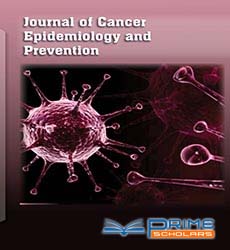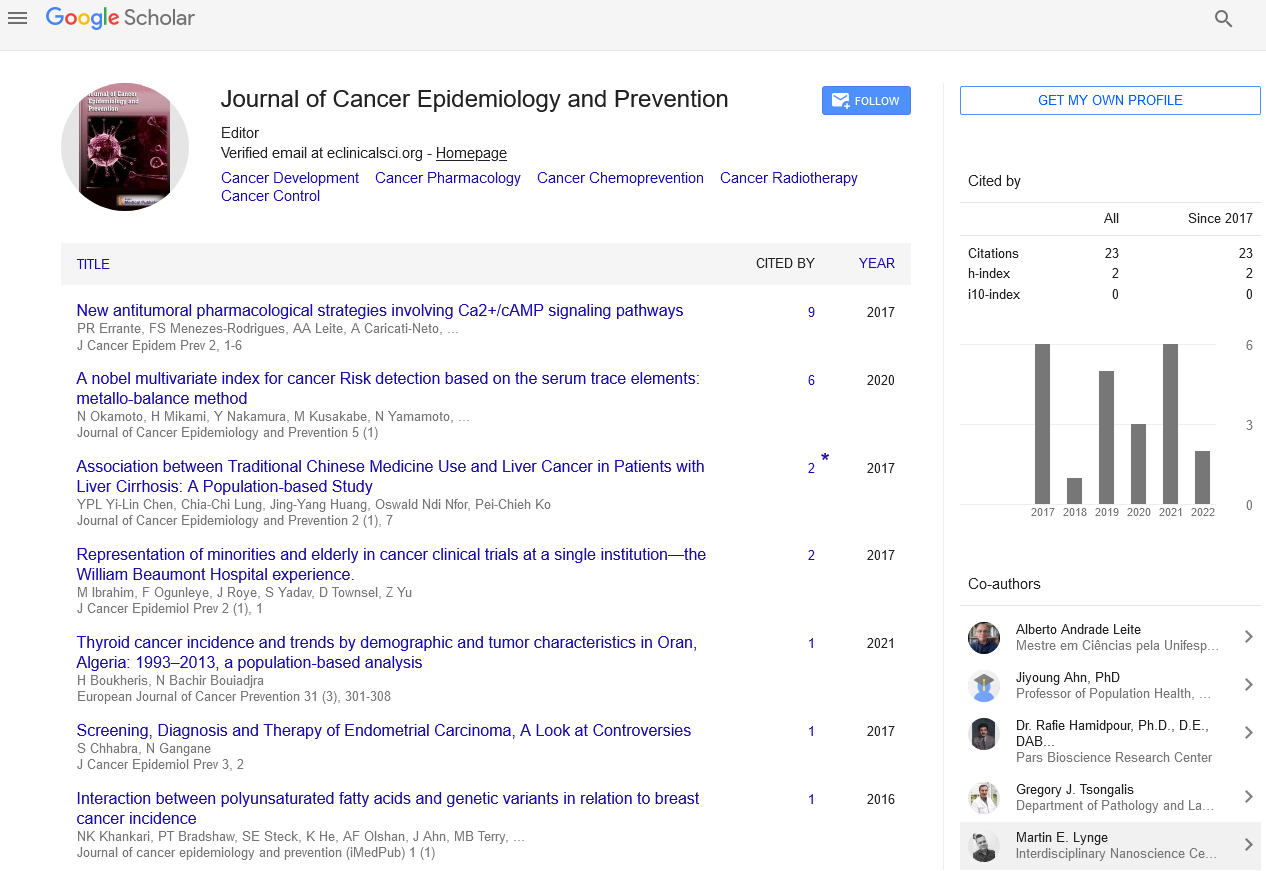Commentary - (2023) Volume 8, Issue 1
The Cancer Prognosis and Characteristics of Parthanato
Daniel Knight*
Department of Radio Oncology, University of Patras, Greece
*Correspondence:
Daniel Knight,
Department of Radio Oncology, University of Patras,
Greece,
Email:
Received: 31-Jan-2023, Manuscript No. IPJCEP-23-16269;
Editor assigned: 02-Feb-2023, Pre QC No. IPJCEP-23-16269 (PQ);
Reviewed: 16-Feb-2023, QC No. IPJCEP-23-16269;
Revised: 21-Feb-2023, Manuscript No. IPJCEP-23-16269 (R);
Published:
28-Feb-2023, DOI: 10.36648/IPJCEP.23.08.007
Description
Targeted therapy has been the subject of a lot of research since
its introduction in the late 1990s and has had a significant impact
on the treatment of certain types of cancer. Utilizing agents
designed specifically for the dysregulated proteins of cancer
cells is the term for this. Drugs for little atom designated treatment
commonly hinder the enzymatic areas of basic proteins
in malignant growth cells that have been transformed, overexpressed,
or in some alternate way compromised. Examples
include the well-known tyrosine kinase inhibitors gefitinib and
imatinib. Another approach, monoclonal immunizer therapy,
uses a specialist as a neutralizer that specifically binds to a protein
on the outer layer of the disease cells. The anti-HER2/neu
immunizer trastuzumab, which is used to treat bosom disease,
and the anti-CD20 neutralizer rituximab, which is used to treat
a variety of B-cell cancers, are examples. As “homing devices,”
small peptides that can connect to cell surface receptors or the
affected extracellular framework surrounding the growth can
also be included in designated treatment. If the nuclide decays
nearby the diseased cell, radionuclides joined to these peptides
eventually kill it. These limiting themes’ oligo- or multimers, in
particular, are of particular interest because they have the potential
to increase growth explicitness and eagerness. Photodynamic
therapy is a ternary treatment for cancer that combines
light, oxygen in the tissue, and a photosensitizer. PDT can be
used to treat cellular breakdown in the lungs or basal cell carcinoma;
PDT can also be used to remove any malignant tissue
that is still present after large tumors have been surgically removed.
Clinical researchers announced in February 2019 that
a photosensitized particle of iridium attached to egg whites
can enter malignant growth cells and, when illuminated with
light, eradicate the disease cells. Compared to standard objective
disease treatment, high-energy restorative ultrasound
may increase the thickness of antimalignant growth drugs and
nanomedicines that target cancer locations. Morphino join exchanging oligonucleotides, which induce ERG exon skirting in
prostate cancer models, multitargeted kinase inhibitors, which
suppress with various pathways including MEK and PIM, and
inhibitors of NF-B in models of chemotherapy resistance, are
designated treatments under pre-clinical development as potential
disease therapies.
Examples of signs include a high body temperature, a rash, or
a bruise. Conversely, an emotional encounter like torment, discombobulation,
or weariness is a side effect of a sickness, disease,
or injury. Using a thermometer with a high reading, for
instance, can indicate a subjective feeling of fever. In any case,
signs and side effects are not fundamentally unrelated. Disease
screening, otherwise called malignant growth reconnaissance,
is a key general wellbeing need because of the overall nature
and slow beginning of numerous malignant growth side effects.
This could include demonstrative imaging tests, actual assessments,
tissue tests, or research facility work that a gathering of
specialists suggests being finished at explicit spans for specific
populaces. Tumors can be found during screenings before side
effects show up or before the infection advances. Antibodies
that protect against the infections that cause certain tumors
can prevent them.
Prostate cancer risk factors include family history, older age,
and race. About 99% of cases occur after the age of 50. When
a first-degree relative has the disease, the risk is two to three
times higher. Additional risk factors include a diet high in red
and processed meat, as well as a high intake of milk products.
There is an association with gonorrhea, however not an obvious
explanation has been given for this association. There is
a link between an increased risk and the BRCA mutations. A
biopsy provides a diagnosis. To decide if metastasis is available,
clinical imaging might be performed. Prostate cancer screening,
which includes testing for the prostate-specific antigen,
improves outcomes but raises the question of whether it also
increases cancer detection. For people between the ages of 55 and 69, informed navigation is recommended. People with a
longer life expectancy benefit most from testing. 5-reductase
inhibitors appear to reduce the risk of low-grade cancer, but
they do not reduce the risk of high-grade cancer, so they should
not be used to prevent it. Risk doesn’t have all the earmarks of
being impacted by nutrient or mineral supplementation.
Acknowledgement
None.
Conflict of Interest
The authors declare that they have no conflict of interest.
Citation: Knight D (2023) The Cancer Prognosis and Characteristics of Parthanato. J Cancer Epidemiol Prev. 8:007.
Copyright: © 2023 Knight D. This is an open-access article distributed under the terms of the Creative Commons Attribution
License, which permits unrestricted use, distribution, and reproduction in any medium, provided the original author and source
are credited.

